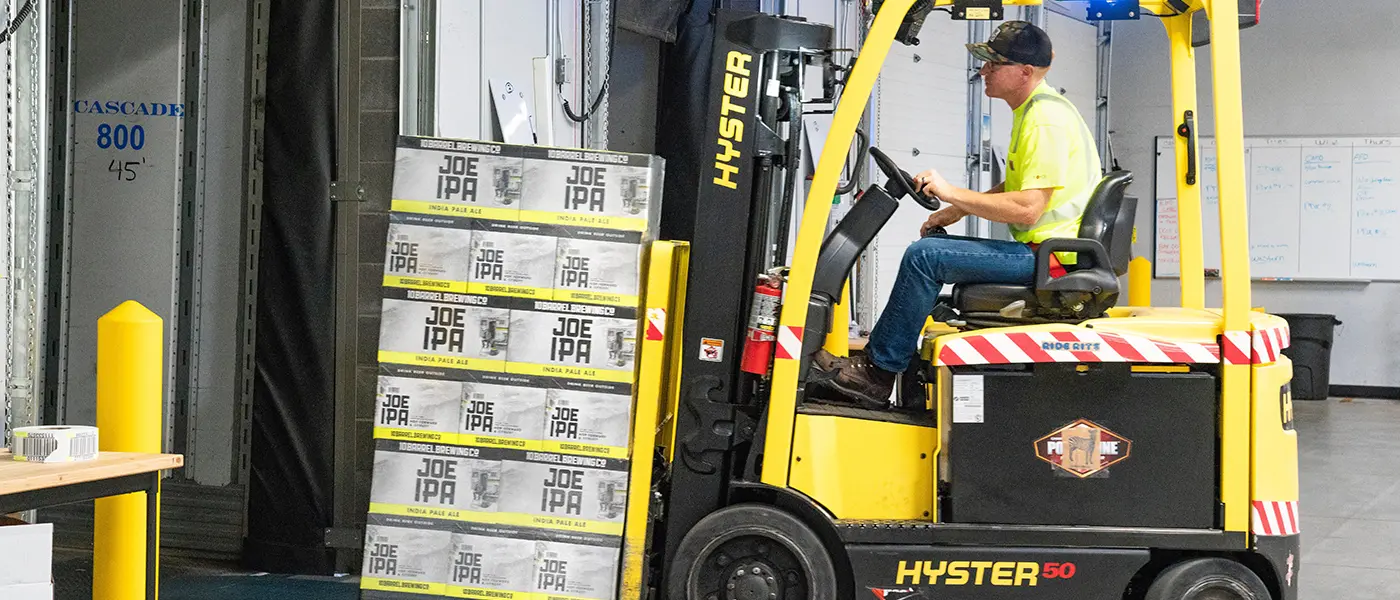Welcome to our comprehensive guide on logistics automation for e-commerce businesses. In today’s fast-paced digital landscape, efficient and streamlined logistics operations are vital for success. You can save time, reduce costs, and enhance customer satisfaction by automating various aspects of your logistics processes.
In this guide, we will explore the definition of e-commerce logistics automation, delve into the key objectives it aims to achieve, address the challenges you may encounter, how to select a logistics automation system, provide best practices to implement, and offer actionable insights to optimise your operations.
Additionally, we’ll equip you with practical templates to help you audit and refine your logistics strategies. So, let’s dive in and unlock the power of logistics automation!
What is Logistics Automation?
Logistics automation refers to the process of using technology and systems to streamline and optimise various aspects of the e-commerce logistics workflow. It involves integrating software, hardware, and intelligent algorithms to automate repetitive tasks, improve efficiency, and enhance overall operational performance.
By automating logistics processes, businesses can eliminate manual errors, reduce dependency on human intervention, and achieve higher levels of accuracy and precision. From inventory management and order processing to warehouse operations and shipping, logistics automation covers a wide range of functions, enabling businesses to deliver products to customers faster and more efficiently.
Why Is Logistics Automation Important?
Logistics automation is of paramount importance in today’s e-commerce landscape due to several compelling reasons:
Automation of Incoming Goods
When incoming goods are marked with barcodes, it automatically notifies the automation system of their arrival. This helps in the scanning and proper identification of goods, which further ensures correct quality assessment and handover to the fixed machinery in the warehousing or distribution unit. It will help your system assign the goods to the appropriate conveyors, cranes, sortation systems, or storage shelves.
Automation in Dispatching
When the logistical functions are automated end-to-end, your automation system can efficiently assign outbound goods to appropriate dispatch units and outgoing stocks. Not only does this optimise the tasks undertaken by machines, but it can also reduce human efforts and costs.
Automation in Packaging & Repackaging
Automation in process logistics can help expedite packaging and repackaging processes, thus saving your company plenty of cash in human labour costs.
Automation of Goods Retrieval
Your automation system can automatically locate and retrieve specific goods from your inventory when an order is received. It can then set up the product for shipment and delivery.
Workforce Reduction
Automating logistics functions can reduce your workforce by a huge margin. Human input throughout your facilities and the product life cycle can be restricted to only a few critical decision-making tasks. At the same time, the grunt work is undertaken by the automation systems. Further, a network of smaller automation systems can be put in place to make the entire supply chain of logistical functions work smoothly.
Logistics Automation Objectives
Several key objectives drive the implementation of logistics automation in e-commerce businesses. By understanding these objectives, you can align your strategies and efforts to maximise the benefits of automation. Here are the primary objectives of logistics automation:
Streamline Order Fulfilment
Logistics automation aims to streamline the entire order fulfillment process, from receiving an order to delivering it to the customer’s doorstep. Businesses can accelerate order fulfillment speed, reduce errors, and improve customer satisfaction by automating order processing, inventory management, and warehouse operations.
Optimise Inventory Management
Efficient inventory management is crucial for e-commerce businesses. Automation helps optimise inventory levels by providing real-time visibility and control over stock. With automation, businesses can track stock levels, forecast demand accurately, and automate reorder points to ensure adequate inventory availability while minimising holding costs.
Improve Operational Efficiency
Logistics automation enables businesses to achieve higher operational efficiency by automating repetitive and time-consuming tasks. Automation systems can handle tasks such as data entry, label printing, order sorting, and shipment tracking, freeing up valuable human resources to focus on more strategic activities.
Enhance Scalability and Flexibility
As e-commerce businesses grow, they need logistics systems that scale and adapt to changing demands. Automation provides the scalability and flexibility required to handle increasing order volumes, accommodate seasonal fluctuations, and expand warehouse operations seamlessly.
Reduce Costs and Errors
By automating logistics processes, businesses can reduce costs associated with labour, manual errors, and inefficient workflows. Automation minimises human errors, optimises resource allocation, reduces labour costs, and eliminates the need for manual data entry, leading to significant cost savings.
Enhance Customer Experience
Logistics automation plays a crucial role in enhancing the overall customer experience. By streamlining order processing, reducing delivery times, providing real-time tracking updates, and ensuring accurate order fulfillment, businesses can deliver customers a seamless and satisfying experience.
Key Activities in Logistics Automation Process
Implementing logistics automation involves key activities essential for achieving successful automation outcomes.
You can effectively plan and execute your logistics automation initiatives by understanding these activities. Here are the key activities involved in the logistics automation process:
![E-commerce Logistics Automation: Definition, Objectives, Challenges, Best Practices & Actionable Insights [+Templates] 2 Key Activities in Logistics Automation Process](https://golocad.com/wp-content/uploads/2023/07/Key-Activities-in-Logistics-Automation-Process.webp)
- Assessing Current Processes: Begin by assessing your existing logistics processes to identify areas that can be automated. Evaluate your order fulfillment, inventory management, warehouse operations, shipping, and other relevant processes. This assessment will help you understand where automation can bring the most significant benefits.
- Defining Automation Goals: Clearly define your automation goals based on the objectives you aim to achieve. Determine the specific areas or tasks you want to automate, such as order processing, inventory tracking, or shipment notifications. Set measurable goals that align with your overall business objectives.
- Selecting Automation Technologies: Research and select the automation technologies that best fit your business needs. This includes choosing software platforms, hardware systems, and intelligent algorithms that align with your automation goals. Consider factors such as scalability, integration capabilities, ease of use, and compatibility with your existing systems.
- Integrating Systems: Ensure seamless integration between your existing systems and your selected automation technologies. This may involve integrating your e-commerce platform, warehouse management system (WMS), inventory management system (IMS), and other relevant systems with automation software and hardware. The integration enables data flow and ensures a smooth end-to-end automation process.
- Implementing Automation: Develop a detailed implementation plan that outlines the steps and timeline for deploying the automation technologies. This includes configuring the software, setting up hardware components, and testing the system for functionality and reliability. Conduct thorough training sessions to familiarise your team with the new automation processes.
- Monitoring and Optimising: Continuously monitor the performance of your logistics automation system to identify areas for improvement. Collect and analyse data on key e-commerce metrics such as order processing time, inventory accuracy, and shipment efficiency. Use this data to optimise your automation workflows, make necessary adjustments, and drive ongoing improvements.
- Employee Training and Support: Provide comprehensive training and support to your employees to ensure they can effectively work with the new automation system. Train them on using the automation software, operating the hardware components, and understanding the new processes. Offer ongoing support to address any questions, challenges, or concerns during the transition.
- Continuous Improvement: Embrace a culture of continuous improvement by actively seeking feedback from your team and customers. Encourage innovation and explore new opportunities for automation within your logistics operations. Regularly review and refine your automation strategies to stay ahead of evolving market trends and customer expectations.
By following these key activities, you can successfully implement logistics automation in your e-commerce business and unlock the full potential of streamlined and efficient logistics operations.
Logistics Management vs. Supply Chain Management
Logistics and Supply Chain Management are two terms that have frequently interchangeable usage in the business world, but they refer…
Common Challenges in E-commerce Logistics Automation
While e-commerce logistics automation offers numerous benefits, there are also challenges that businesses may encounter during the implementation and operation of automated logistics processes. Here are some common challenges:
System Integration Headaches
Integrating logistics automation software with existing systems, such as e-commerce platforms, inventory management systems, and warehouse management systems, can be complex and time-consuming. Ensuring seamless data flow and compatibility between different systems requires careful planning and coordination.
Scaling Up with Efficiency
As e-commerce businesses grow and experience increased order volumes, the logistics automation system must be able to scale accordingly. Ensuring the system can handle higher transaction volumes, accommodate seasonal fluctuations, and support business expansion is crucial for long-term success.
Managing Change and Adoption
Implementing logistics automation often involves changes in processes, roles, and responsibilities. Employees may need to adapt to new working methods and receive training on using automation software and hardware. Managing the change and ensuring smooth adoption throughout the organisation is essential.
Tackling Data Accuracy and Quality Issues
Logistics automation heavily relies on accurate and high-quality data. Inaccurate or incomplete data can lead to errors in order processing, inventory management, and shipment tracking. Maintaining data integrity and establishing data governance processes are important for successful automation.
Meeting Infrastructure and Technology Demands
Logistics automation may require investments in hardware, such as barcode scanners, conveyor belts, robotics, and warehouse automation systems. Assessing and acquiring the necessary infrastructure and technology can be a significant challenge, especially for small and medium-sized e-commerce businesses with limited resources.
Dealing with System Downtime and Reliability Concerns
Any system downtime or technical issues can disrupt logistics operations and impact customer satisfaction. Ensuring the reliability and uptime of the automation system and having contingency plans in place is crucial to minimising the risk of disruptions.
Handling Complex Order Fulfilment Scenarios
E-commerce businesses often face complex order fulfillment scenarios, such as multiple items in a single order, split shipments, or special handling requirements. Designing automation processes that can handle these complexities accurately and efficiently can be challenging.
Navigating Return and Reverse Logistics Challenges
Managing returns and reverse logistics can be challenging in an automated environment. Developing processes and systems that efficiently handle returned products, refunds, exchanges, and inventory reconciliation is essential to maintain customer satisfaction and minimise costs.
Addressing these challenges requires careful planning, continuous monitoring, and iterative improvements. It is important to have a well-defined implementation strategy, consider the business’s specific needs, and work closely with vendors and technology partners to overcome these challenges and maximise the benefits of e-commerce logistics automation.
What is Logistics Automation Software System?
Logistics automation software or system refers to specialised software solutions designed to streamline and optimise various aspects of the logistics process in e-commerce businesses. It integrates with existing systems and uses technology, such as intelligent algorithms and data analytics, to automate repetitive tasks, improve operational efficiency, and enhance overall performance.
Logistics automation software typically offers a range of features and functionalities, including:
- Order management: Automates the processing, tracking, and fulfillment of orders from start to finish.
- Inventory management: Provides real-time visibility and control over stock levels, allowing businesses to optimise inventory and reduce holding costs.
- Warehouse management: Automates warehouse operations, including goods receiving, put-away, picking, packing, and shipping, improving efficiency and reducing errors.
- Transportation management: Optimises the planning, routing, and tracking of shipments, ensuring timely and cost-effective delivery.
- Data analytics: Collects and analyses data on key logistics metrics, enabling businesses to identify bottlenecks, make data-driven decisions, and continuously improve processes.
- Integration capabilities: Integrates with e-commerce platforms, ERP systems, WMS, IMS, and other relevant systems to ensure seamless data flow and end-to-end automation.
- Reporting and dashboards: Provides comprehensive reporting and intuitive dashboards to monitor performance, track KPIs, and gain actionable insights.
- Customer communication: Automates customer communication, providing real-time order updates, delivery notifications, and tracking information.
Logistics automation software allows businesses to streamline operations, reduce costs, improve efficiency, and enhance customer experience. By leveraging technology and automation, E-commerce businesses can stay competitive in a rapidly evolving digital landscape.
How to Select a Logistics Automation Software System?
Selecting the right logistics automation software system is a critical decision that can significantly impact your e-commerce logistics operations. Here are the key steps to follow when selecting a logistics automation software system:
![E-commerce Logistics Automation: Definition, Objectives, Challenges, Best Practices & Actionable Insights [+Templates] 3 Steps to Select a Logistics Automation Software System](https://golocad.com/wp-content/uploads/2023/07/Steps-to-Select-a-Logistics-Automation-Software-System-scaled.webp)
- Identify Your Needs and Objectives: Begin by clearly defining your requirements and objectives for logistics automation. Consider the specific challenges you want to address, such as order processing, inventory management, warehouse operations, or shipping. Determine the functionalities and features you need in a software system to meet your business goals.
- Conduct a Needs Assessment: Evaluate your current logistics processes and identify the pain points and inefficiencies you want to address with automation. Assess the volume of orders, inventory size, shipping requirements, and any unique aspects of your business. This assessment will help you understand the specific needs and capabilities required from the software system.
- Research Available Solutions: Conduct thorough research to identify logistics automation software providers in the market. Explore their websites, read customer reviews, and analyse the features and functionalities they offer. Look for software systems that align with your requirements and have a track record of success in the e-commerce industry.
- Evaluate Features and Functionality: Create a checklist of your business’s important logistics features and functionalities. This may include order management, inventory tracking, warehouse management, shipping integration, reporting and analytics, and integration capabilities with other systems. Evaluate each software system against your checklist to assess how well they meet your needs.
- Consider Scalability and Flexibility: Ensure the software system can scale and adapt to accommodate your growing business needs. Consider factors such as the maximum order volume the system can handle, the ability to integrate with additional sales channels or marketplaces, and the capacity to support seasonal fluctuations in demand.
- Integration with Existing Systems: Determine how well the logistics automation software system integrates with your existing systems, such as your e-commerce platform, inventory management system, or warehouse management system. Seamless integration is crucial for efficient data flow and automated workflows.
- User-Friendliness and Ease of Implementation: Consider the software system’s user interface and overall user-friendliness. Evaluate how easy it is to set up, configure, and implement the system within your organisation. User training and support resources should also be taken into account.
- Vendor Support and Reputation: Research the reputation and customer support services of the logistics automation software providers you are considering. Look for vendors with a strong track record of customer satisfaction, responsive support teams, and ongoing software updates and improvements.
- Total Cost of Ownership: Evaluate the total cost of ownership, including upfront costs, licensing fees, ongoing maintenance and support fees, and any additional costs such as customisation or integrations. Consider the return on investment (ROI) and the potential cost savings and efficiency gains the software system can provide.
- Request Demos and Trial Periods: Request demos or trial periods from the shortlisted software providers to get hands-on experience with the system. This allows you to evaluate the software’s user interface, functionality, and overall suitability for your business.
- Seek References and Feedback: Reach out to other e-commerce businesses that have implemented the software systems you are considering. Ask for references and gather feedback on their experiences with the software, including its effectiveness, reliability, and vendor support.
- Make an Informed Decision: Based on your evaluation, compare the pros and cons of each software system and make an informed decision that aligns with your requirements, objectives, and budget.
By following these steps and conducting thorough research and evaluation, you can select a logistics automation software system that best meets your business needs, improves operational efficiency, and drives the success of your e-commerce logistics operations.
Expert Actionable Insights for Logistics Automation (From Team Locad)
Here are some expert actionable insights for logistics automation that can help optimise your operations:
- Start with a Pilot Project: Implementing logistics automation can be a complex process. Consider starting with a pilot project to test the selected automation system on a smaller scale. This allows you to identify potential challenges or issues and adjust before scaling up.
- Prioritise Integration: Seamless integration between your existing systems and the logistics automation software is crucial for smooth operations. Ensure that the automation system can integrate with your e-commerce platform, inventory management system, and other relevant systems to enable efficient data flow and process synchronisation.
- Leverage Real-Time Data: Utilise the power of real-time data provided by the automation system. Monitor key metrics such as order processing time, inventory levels, and shipping performance to make data-driven decisions and identify areas for improvement. This allows you to optimise processes, minimise delays, and enhance overall efficiency.
- Focus on Training and Change Management: Effective training and change management are essential for successfully adopting logistics automation. Invest in comprehensive training programs to ensure your team understands how to utilise the automation system effectively. Address any resistance to change by communicating the benefits and providing ongoing support.
- Continuous Monitoring and Optimization: Logistics automation is not a one-time implementation. It requires continuous monitoring and optimisation. Regularly assess the logistics KPI performance of the automation system and identify areas where further improvements can be made. Stay updated on emerging technologies and industry best practices to stay ahead of the competition.
- Collaborate with a Trusted Logistics Partner like Locad: Implementing logistics automation can be complex. Consider partnering with a trusted logistics automation provider like Locad. With their expertise in e-commerce logistics and automation, Locad can help you navigate the process, provide tailored solutions, and ensure successful implementation.
Connect with Locad, your trusted logistics and fulfillment automation provider in Asia Pacific, to streamline your e-commerce operations. With our deep expertise in e-commerce logistics and automation, we can help you optimise your logistics processes, improve efficiency, and drive business growth.
Partnering with Locad will ensure a seamless and successful implementation of logistics automation, empowering your business to thrive in the competitive e-commerce landscape.





